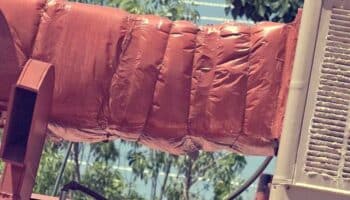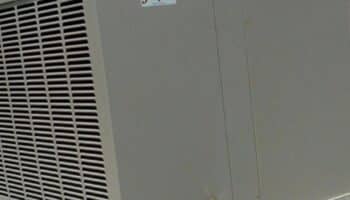If you have a swamp cooler that’s making thing too humid, you’ve got issues.
That’s not meant to say there aren’t solutions. It’s more like an acknowledgement that you’re here for a reason. It’s hot and the last thing you want from your swamp cooler is to make it more humid than is comfortable.
Also, you definitely don’t want your swamp cooler to make it more humid while not making it cooler where you’re at. If your cooler is acting that way, it’s not really a swamp cooler anymore. More like a swamp maker, right?
Yeah, that’s a bad joke. And one you’re probably not laughing at because you’re here for a reason. So, let’s take a look at why your swamp cooler is making things too humid and what you can try to correct it.
1. Water and Your Swamp Cooler
Water and swamp coolers go together like peas and carrots someone once said – never.
But the simple truth is you can’t have a functioning swamp cooler without water. If you don’t have water, the whole evaporative process the swamp cooler is designed to execute is stopped before it ever really gets started.
And because a swamp cooler doesn’t rely on things like refrigerant for cooling like an air conditioner, if you don’t have water, you’ve got no cooling, period.
So, if you have a swamp cooler that has water supplied to it and it’s making things more humid than it should, the answer isn’t to shut off the water, not refill it, or drain it as if you’re putting it into long term storage. If you’re going to do that, you might as well shut the whole cooler down and walk away from it.
Nor do you need to call a technician right away. There are a few things to check out before picking up that phone for help with your humidity issue.
First, though, make sure you leave the water supply as is. You’re going to need water to troubleshoot your cooler, after all.
So, if you have a water hose connection, make sure the water’s on. If you’ve got a hand-filled reservoir, make sure there’s water in the tank.
There, the first step is out of the way. You have a good supply of water. Now, let’s dig deeper and see why the humidity is up where it shouldn’t be.

2. Let Those Pads Soak for a Bit
Before turning the fan on for you swamp cooler, fire up the water pump and let it circulate the water from the reservoir or tank to the water pads. You don’t have to do it for long before starting the fan. Just long enough to make sure the pads are good and soaked with cool water.
Why do this?
Well, think of it like priming a pump. To get better rotation and positive displacement with a pump. It’s often good practice to prime it or inject a little of whatever the pump normally moves before normal operation.
In this case, you’re priming the entire water system of the swamp cooler. You’re ensuring water is being positively moved from the reservoir through the pump and to the distributer tubing and ultimately to the pads.
Completing this process for a few minutes ensures proper operation of the water side is occurring before the fan is started. It also ensures proper water distribution before the fan kicks in and starts evaporating that same water.
What happens if you don’t do this?
Well, in terms of humidity, you may get more humid than normal air blown out by the fan because it’s evaporating moisture that hasn’t been evenly distributed across the pads yet.
As a result, the air may be cooler but also more moisture-rich than if you ran the water by itself for 10 – 15 minutes prior to firing up the fan.
3. Humidity and Your Swamp Cooler
If you live in a hot arid part of the planet, you’re probably used to using a humidifier from time to time. Yes, a swamp cooler also produces some humidity in the cool air it distributes but that doesn’t mean you need a swamp cooler year round.
Often hot dry areas aren’t hot all the time. If you live in a desert region, you understand how cold it can get, especially at night, even during times of the year when it’s hot during the day.
That doesn’t mean when it cools off outside it also magically becomes more humid, too.
As a result, to still deal with dry air, you may run a humidifier in your home, especially at night to help with sleep.
But like the name implies, humidifiers do exactly as the name advertises. So, before firing up your swamp cooler the next day after a night of running your humidifier, you may want to open a bunch of windows and let your place air out naturally to rid it of the extra humidity.
Why?
Well, if you leave the lingering humidity created by the humidifier and then fire up the swamp cooler, you’ll be peeling humidity introduced by the swamp cooler on top of the humidity created by the humidifier.
Suddenly, your place will feel a lot more humid. But it’s not the swamp cooler’s fault even though you may think it is.
The other thing you can do is run a dehumidifier in conjunction with the swamp cooler until the humidity level balances out. You should still open windows to provide natural air flow for your swamp cooler, but a dehumidifier will help things balance out faster.
4. Humid Weather
Just as you’re being advised to open up the windows and let natural air in, let’s cover a time when maybe you don’t want to open up windows.
That time, is of course, when the weather outside feels like your home was mystically transported to a rain forest.
Yes, hot arid regions still, from time to time, experience humid weather. Usually, this is due to an influx of tropical moisture. It doesn’t happen all the time but it does happen. And if you live in an area where you depend on a swamp cooler, you already know how frustrating that tropical moisture can be.
Why?
Well, swamp coolers rely on hot dry air to be effective in making cool, moist air. If the air is already hot and moist, your cooler may be able to cool the air a bit, but it’ll definitely make it more humid.
Instead of it being hot and dry like an oven, your place may now feel hot and moist while everything suddenly feels like it’s got a wet film on it.
Not pleasant.
If the weather is like this, it’s probably best not to use the swamp cooler at all. Actually, the dehumidifier would probably be the better option.
5. Plants
One tip that a lot of people that live in humid climates already know is to get some houseplants that thrive on humidity. They’ll naturally absorb moisture in the air while helping make the air feel cooler and fresher.
Not a complete solution but one that won’t hurt your fight against humidity.

6. Cool Water
If you weren’t aware, cool water is better for the evaporative process than warm water. As a result, cool water evaporates faster and disperses quicker than warmer water when using it in your swamp cooler.
How does this affect the humidity level in your home?
The better question is how does it affect the perception of the humidity level in your home? If your swamp cooler is producing colder air with colder water from the tank, it’ll probably feel less humid compared to a swamp cooler that’s producing warmer air.
Think of it this way, if the cooler isn’t producing air that’s as cool as you want it to be, won’t you also notice other things like if the air feels damper or stickier?
Where as if the air is cool and making things comfortable, will you really think much about the moisture content?
Sometimes it really boils down to being comfortable. Now, most tap water is already cool so not much has to be done. However, if you want to ensure your water in the tank stays cold, adding a couple of frozen ice packs in the tank won’t hurt and will ensure water circulating through the system remains nice and cool.
Conclusion
It goes without saying that anything called a swamp cooler probably involves water. With it, comes the promise of air that is cool and moist, which are both very beneficial products for anyone living somewhere that’s both hot and dry, especially if you’re a person with sinus issues.
That all being said, a swamp cooler that is heavy on the humidity isn’t always welcome. Thankfully, it’s not an uncorrectable feature if you’re experiencing a cooler that’s acting more like a regular old humidifier than the cooling appliance you expect it to be.







